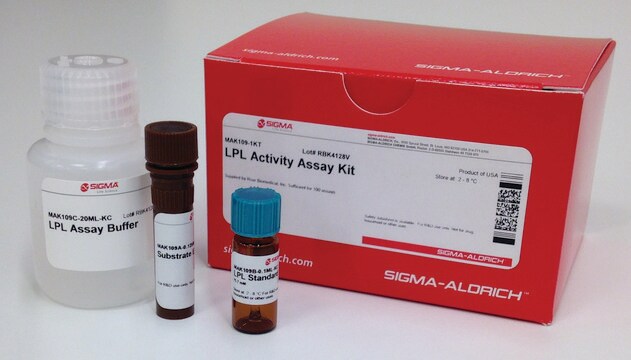MAK277
GAPDH Activity Assay Kit
sufficient for 100 colorimetric tests
Synonym(s):
Glyceraldehyde-3-phosphate Dehydrogenase Activity Assay Kit
Sign Into View Organizational & Contract Pricing
All Photos(1)
About This Item
UNSPSC Code:
12161503
NACRES:
NA.84
Recommended Products
detection method
colorimetric
relevant disease(s)
cancer
storage temp.
−20°C
General description
GAPDH (Glyceraldehyde-3-Phosphate Dehydrogenase; EC 1.2.1.12) catalyzes the conversion of Glyceraldehyde-3-Phosphate (GAP) to 1, 3-Bisphosphate Glycerate (BPG) and plays a key role in glycolysis. The enzyme is involved in cellular processes such as apoptosis, membrane trafficking, iron metabolism and nuclear translocation. GAPDH (housekeeping gene) expression is stable and constitutive. Deregulation of GAPDH activity is associated with abnormal cell proliferation and carcinogenesis. Accurate quantitation of GAPDH activity is important for diagnosing diseases and studying normal cellular physiology.
Application
GAPDH Activity Assay Kit has been used to measure the enzyme activity of glyceraldehyde-3-phosphate dehydrogenase in testis.
Features and Benefits
Compatible with high-throughput handling systems.
Suitability
Suitable for use with various tissue and cell culture samples.
Principle
The GAPDH Activity Assay Kit provides a simple and sensitive method for monitoring GAPDH activity in various samples. GAPDH activity is determined in a coupled enzyme reaction in which GAP is converted to BPG by GAPDH. This results in a colorimetric (450 nm) product proportional to the enzymatic activity present. The assay is sensitive to 100 mUnits/mL. One unit of GAPDH activity is the amount of enzyme that will generate 1.0 mmole of NADH per minute at pH 7.2 at 37 °C.
Signal Word
Danger
Hazard Statements
Precautionary Statements
Hazard Classifications
Aquatic Chronic 3 - Eye Dam. 1 - Skin Corr. 1B
Storage Class Code
8A - Combustible corrosive hazardous materials
Certificates of Analysis (COA)
Search for Certificates of Analysis (COA) by entering the products Lot/Batch Number. Lot and Batch Numbers can be found on a product’s label following the words ‘Lot’ or ‘Batch’.
Already Own This Product?
Find documentation for the products that you have recently purchased in the Document Library.
Customers Also Viewed
Altered expression profile of glycolytic enzymes during testicular ischemia reperfusion injury is associated with the p53/TIGAR pathway: effect of fructose 1, 6-diphosphate.
May A L and Renno W M
PeerJ, 4, e2195-e2195 (2016)
Samir El Qaidi et al.
Scientific reports, 11(1), 3834-3834 (2021-02-17)
Type III secretion system effector proteins have primarily been characterized for their interactions with host cell proteins and their ability to disrupt host signaling pathways. We are testing the hypothesis that some effectors are active within the bacterium, where they
May Al-Maghrebi et al.
PeerJ, 4, e2195-e2195 (2016-07-22)
Background. Testicular ischemia reperfusion injury (tIRI) is considered the mechanism underlying the pathology of testicular torsion and detorsion. Left untreated, tIRI can induce testis dysfunction, damage to spermatogenesis and possible infertility. In this study, we aimed to assess the activities
Our team of scientists has experience in all areas of research including Life Science, Material Science, Chemical Synthesis, Chromatography, Analytical and many others.
Contact Technical Service

